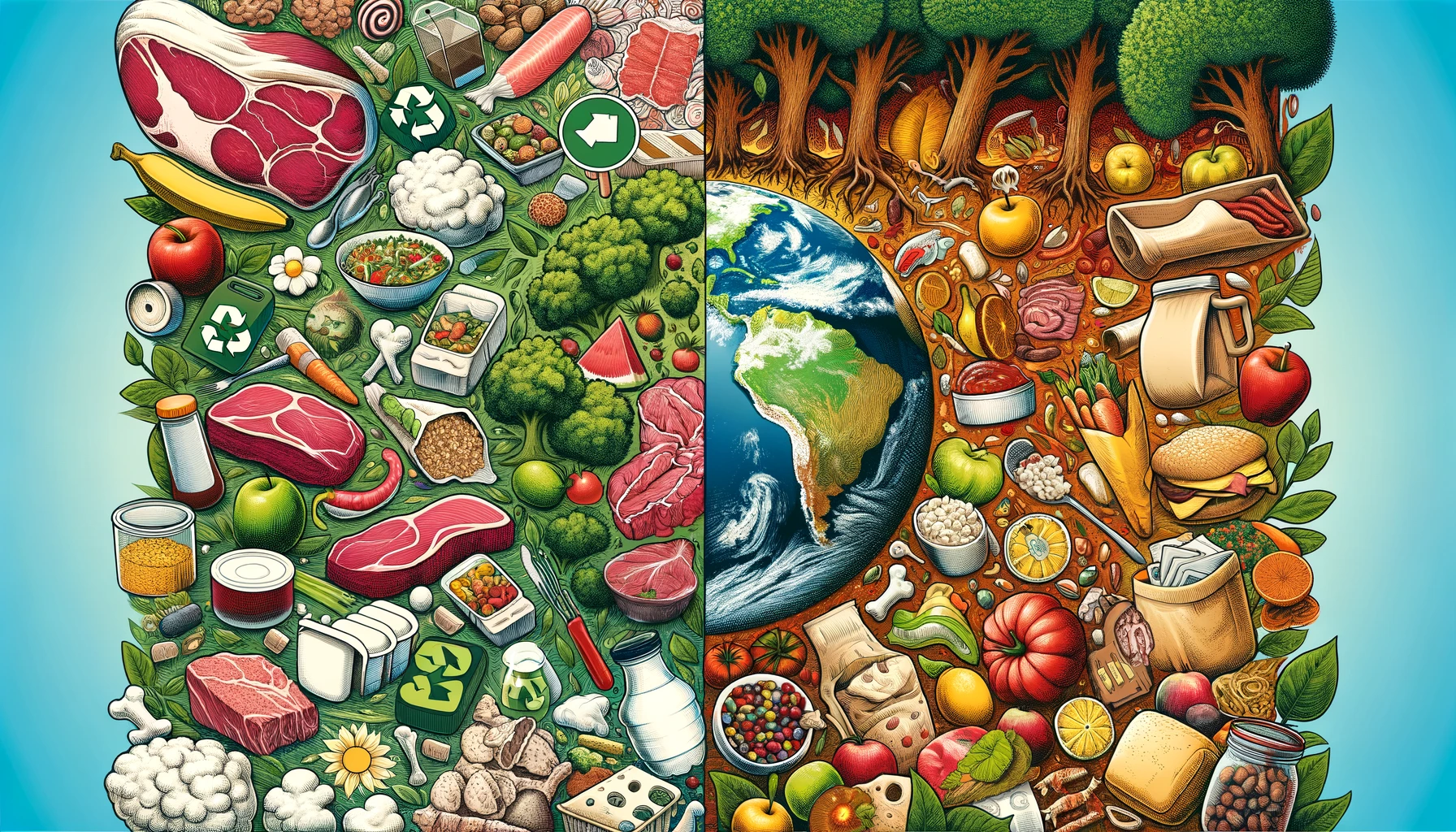Did you know that our diet emits about 10% of the greenhouse gases that cause global warming?
We can greatly reduce our environmental impact with a little effort, from food selection to cooking methods and leftovers.
In this article, we will introduce foods that have a high environmental impact and tips on how to choose eco-friendly foods.
Let’s start with what you can do today to protect the global environment.
Foods with high environmental impact
Impact of Livestock Products
Beef
Beef production is one of the foods with the highest environmental impact.
Methane gas from cow burps and excrement has a greenhouse effect 25 times greater than carbon dioxide and is a major contributor to global warming.
In addition, it takes more than 15,000 liters of water to raise one cow!
This is more water than we use in a day.
In addition, deforestation is sometimes carried out to secure the land necessary for raising cattle.
In the Amazon rainforest, pasture expansion is one of the main causes of deforestation.
Reducing beef consumption is an important step toward protecting the global environment.
Pork
Pork similarly requires large amounts of feed and water.
Each pig requires about 4.8 kg of feed, and vast tracts of farmland and water resources are used for its production. Water pollution from pig excrement is also a serious problem.
Sewage discharged from piggeries contains high concentrations of nitrogen and phosphorus, causing eutrophication of rivers and oceans.
Eutrophication leads to abnormal growth of algae, creating a “dead zone” that deprives the water of oxygen and kills fish and shellfish.
Reducing pork consumption will help preserve the aquatic environment.
Poultry and Eggs
Raising chickens is another food source with a high environmental impact.
Soybeans are used to feed chickens, many of which are grown on farmland created by deforestation.
In addition, excrement emitted from hen houses produces ammonia gas, which also causes air pollution.
In addition, egg production requires a lot of water and energy.
It takes more than 200 liters of water to produce one egg!
Reducing consumption of poultry and eggs helps protect forests and conserve water resources.
Pitfalls of foodstuffs coming from far away
Imports
Imported foodstuffs such as bananas and avocados are problematic because of the CO2 emissions associated with their long-distance transportation.
For example, transportation of bananas from South America to Europe emits about 0.5 kg of CO2 per kg.
Furthermore, large-scale plantation agriculture in exporting countries causes environmental problems such as deforestation, soil degradation, and water resource depletion.
For example, in Mexico, a major exporter of avocados, the expansion of avocado plantations is causing deforestation.
Consuming less imported foods and choosing local foods will help protect the environment.
Out-of-Season Ingredients
Out-of-season produce such as strawberries and tomatoes are problematic because of the large amount of energy consumed by greenhouse cultivation. Fossil fuels are often used to heat greenhouses, which increases CO2 emissions.
Greenhouse cultivation also tends to use more chemical fertilizers and pesticides, leading to soil and water pollution. Choosing seasonal produce can help reduce energy consumption and environmental pollution.
Energy consumption of processed foods
Processed Foods
The production process of processed foods, including instant and frozen foods, consumes a lot of energy.
There are CO2 emissions at each stage of the process, including transportation of raw materials, processing, packaging, and refrigeration/freezing.
For example, the energy required to produce a bag of potato chips is equivalent to 10 potatoes baked in an oven at 160°C for 30 minutes.
Consuming less processed food and eating a homemade diet will help reduce energy consumption.
Retort pouch foods
Retort pouch foods consume a lot of energy because they require sterilization at high temperatures and pressures.
In addition, packaging materials such as aluminum pouches are difficult to recycle, leading to waste problems.
The production of retort pouch foods also requires large amounts of water.
For example, a single serving of retort-pouch curry requires a whopping 3.5 liters of water.
Consuming less retort pouch food and making more homemade meals will save energy and water.
Tips for choosing eco-friendly food
Keep local production for local consumption.
Choosing locally produced, seasonal foods can greatly reduce CO2 emissions from transportation.
Local produce is also fresher and more nutritious, which has health benefits.
Here are some tips for practicing local production for local consumption.
- Buy food directly from local farmers (direct sales, farmers’ markets, etc.)
- Participate in exchange events with local farmers (farming experience, harvest festivals, etc.)
- Grow vegetables in your own vegetable garden or community garden
- Participate in cooking classes using local ingredients
Incorporate plant-based foods
By replacing meat with plant-based foods such as legumes, vegetables, and grains, you can significantly reduce your environmental footprint.
Plant-based foods require fewer resources to produce and have lower CO2 emissions.
Soy products such as tofu, natto (fermented soybeans), and tempeh, as well as meat substitutes such as jackfruit and seitan, are also gaining attention as meat alternatives.
Here are some tips for incorporating plant-based foods
- Find meatless vegetarian recipes.
- Reduce the amount of meat and increase the amount of vegetables (e.g., stir-fried meat and vegetables → stir-fried vegetables).
- Use soy products such as tofu or natto instead of meat
- Try alternative meats such as jackfruit or seitan
Refer to eco-labels
It is also important to choose foods produced in an environmentally and socially responsible manner, such as organic or fair trade.
Refer to eco-labels to ensure that you are choosing sustainable foods.
Typical eco-labels include the Organic JAS Mark, Rainforest Alliance Certification, and MSC (Marine Stewardship Council) Certification.
Here are some tips for choosing eco-labeled foods
- Check the eco-label on the food package.
- Prioritize the purchase of eco-labeled foods.
- Find out what ecolabels mean and the criteria for certification.
- Support sustainable production by purchasing eco-labeled foods
Reduce food loss
Food loss occurs at all stages from production to disposal, leading to the waste of large amounts of resources and labor.
Key points for reducing food loss at home include planned shopping, cooking the right amount of food, and reusing surplus food.
When eating out, it is also important to order the amount of food that can be eaten and to avoid leftovers as much as possible.
Here are some tips for reducing food loss
- Check the contents of your refrigerator before shopping and buy only the ingredients you need.
- Find recipes to use up food without wasting it.
- Freeze leftover food and use it at a later date.
- When eating out, choose small portions or half-size portions.
- Take home leftover food and use it for the next meal.
Summary
We are making a big impact on the global environment with our food choices.
By avoiding foods with a high environmental impact and choosing eco-friendly foods, we can lead a sustainable diet.
It is also important to reduce food loss and waste.
We can practice eco-friendly eating habits by trying to consume locally, incorporating plant-based ingredients, and referring to eco-labels.
Furthermore, we can reduce the waste of resources by incorporating innovations to reduce food loss into our daily lives.
Each of us can help protect the global environment by choosing eco-friendly foods and reducing food loss.
Let’s start with what we can do today. Let’s work together to achieve a delicious, healthy, and earth-friendly diet!




Comment